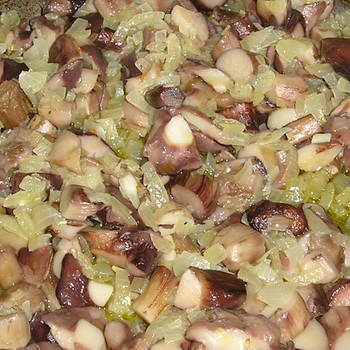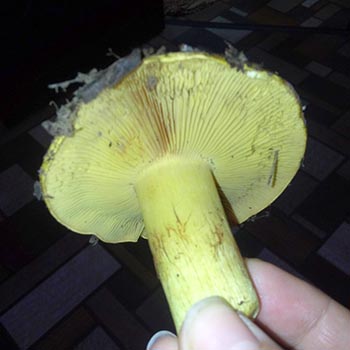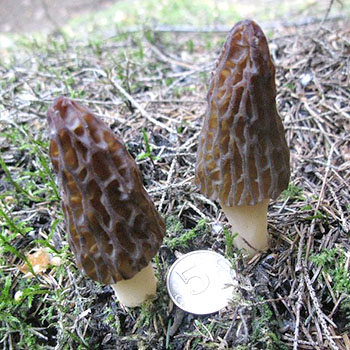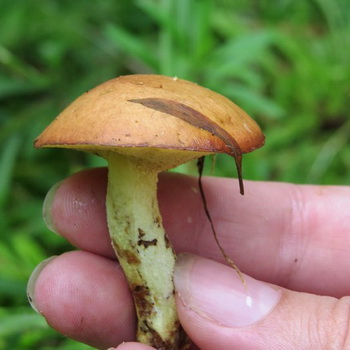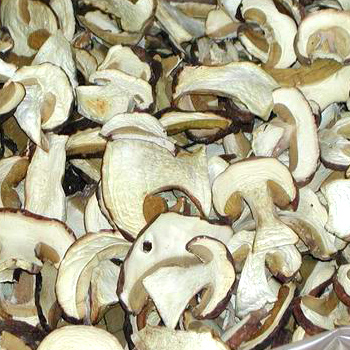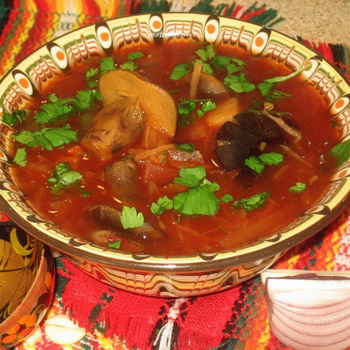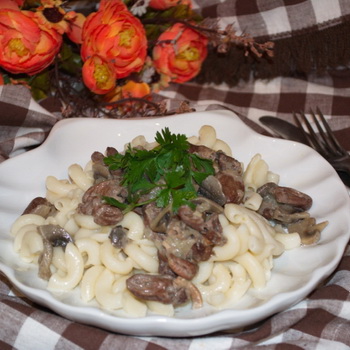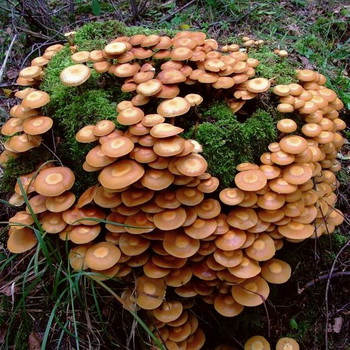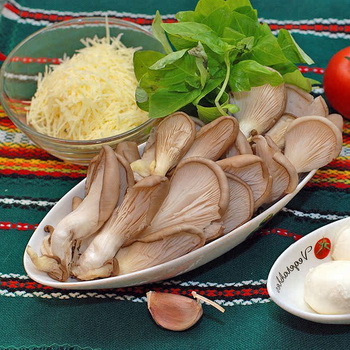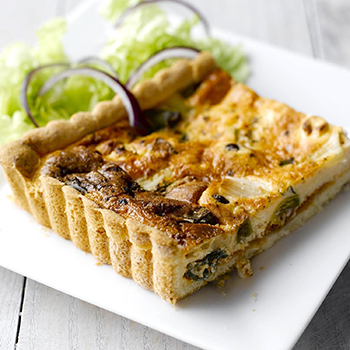Mushroom pale toadstool: what it looks like in the photo, how to distinguish a poisonous mushroom, poisoning
 The pale grebe mushroom is one of the most dangerous poisonous representatives of the forest flora. You cannot pick these mushrooms. They can cause poisoning even with short-term contact with other types of edible mushrooms. Poisons are quickly absorbed into the caps and legs of the edible types. Therefore, it is necessary to know what a pale grebe looks like and how to distinguish it from similar edible mushrooms. All this can be learned from the proposed material.
The pale grebe mushroom is one of the most dangerous poisonous representatives of the forest flora. You cannot pick these mushrooms. They can cause poisoning even with short-term contact with other types of edible mushrooms. Poisons are quickly absorbed into the caps and legs of the edible types. Therefore, it is necessary to know what a pale grebe looks like and how to distinguish it from similar edible mushrooms. All this can be learned from the proposed material.
Description of the mushroom pale toadstool, where it grows (with photo)
The description of the mushroom Adena toadstool gives a general idea of the plant. Next, you can read the description of the pale toadstool with a photo and remember this mushroom.
Family: Fly agaric (Amanitaceae).
Synonyms: fly agaric green.
Cultural-historical and other interesting information
The pale grebe is the most poisonous of our fly agarics and one of the most poisonous mushrooms in general. Statistics: if about 95% of all known fatal mushroom poisonings are caused by species of the genus Amanita, then, in turn, more than 50% of all fatal mushroom poisonings are attributed to the pale toadstool. # 1 killer mushroom, cleaner than a man-eating shark.
In the world, the pale grebe is widespread. Its homeland is Europe, from where it has penetrated East Asia, Africa, both America and even Australia and New Zealand in recent decades. There are many different places where the pale grebe grows, although it is not so common.
Mycorrhizal northern and mid-lane European woody partners of the pale toadstool are oak, linden, hazel, birch, maple, elm, beech, hornbeam, in the southern regions there is also chestnut. Quite rarely, but, nevertheless, successfully grebe is able to form mycorrhiza with pine and spruce. It is noteworthy that in new places, in the process of introduction, the pale grebe finds new, previously uncharacteristic partners for it. For example, in coastal California A. phalloides developed hemlock (coniferous tree) and Virginia oak, in Iran - hazelnuts, in Tanzania and Algeria - eucalyptus, in New Zealand - various species of myrtle tree.
The following is a pale toadstool in the photo of different variations of the mushroom by the color of the cap:




At the end of the 19th century, the famous American mycologist Charles Peck announced the discovery of the European species A. phalloides in North America. However, in 1918 these samples were tested and identified by the mycologist Professor Atkinson (Cornell University) as a similar species of A. brunnescens. The question of the transcontinental nature of the pale toadstool seemed to be closed, but in the 1970s it suddenly became clear that the undoubted European pale toadstool colonized both the eastern and western North American coasts, having moved from Europe along with the seedlings of the then popular chestnuts. In general, the pale grebe, having taken a start in Europe, captured the entire Northern Hemisphere in exactly this way - along with seedlings and commercial timber. It took her about 50 years to do everything. Together with oak seedlings, she penetrated to Australia and South America (green round dances around the grown oak trees were “pleasing to the eye” for a long time in Melbourne and Canberra, as well as in Uruguay, Argentina and Chile, until a few years later the mushrooms found new mycorrhizal partners and started procession across continents). It has been reliably established that, with pine saplings, the pale grebe "jumped" to Tanzania and South Africa, where it quickly mastered the local oaks and poplars.
All this speaks of a very high invasive potential of the pale toadstool, which for some reason (warming? .. activity of phytodesigners? ..) has become more and more manifested in recent years.
Since ancient times, people have been poisoned by the pale toadstool, both by accident and by malicious intent.Perhaps the earliest known case of poisoning with the pale toadstool (eaten by mistake instead of the Caesar mushroom) can be considered the death of the wife and children of the great playwright of antiquity Euripides.
History has brought to us a lot of facts and deliberate "persecution" of famous personalities with poisonous mushrooms to remove them from the political or even religious arena. Apparently, most of them fall on the share of the pale toadstool. The most frequently mentioned "lucky ones" in this regard are the Roman emperor Claudius and Pope Clement VII.
How poisonous mushrooms look like pale toadstool in the photo: how to distinguish them?
Consider what a pale toadstool looks like: a cap from ovoid to flat-convex, with age, prostrate, slimy or dry, 6-12 cm in diameter, greenish to yellowish-olive, usually with dark, ingrown fibers, rarely almost white or dark - olive brown. At a young age, white flaky warts are scattered on the surface of the cap, which disappear in adult fruiting bodies or after rain. The pulp is white, rather thin. The plates are wide, white. Stem 10-15 X 1.5-2 cm, cylindrical with a tuberous-expanded base, white, yellowish or greenish, smooth or with scales. Volvo is cup-shaped, wide, free (not adhered to the stem by the edges, as, for example, in the red fly agaric), white, usually torn at the top into 3-4 parts (blades). The ring is white, slightly striped from above, usually erect, in the upper part of the leg. The smell and taste (at least in young mushrooms) are very pleasant. In old mushrooms, the smell becomes sweetish-unpleasant, like crushed insects.
The following shows what a pale toadstool looks like in a photo illustrating various forms:




By our standards, the pale grebe is quite thermophilic and prefers deciduous and deciduous forests. The favorite habitat of this fungus in the European part of Russia is lime and oak forests. The green fly agaric is found throughout the taiga zone, but still feels better in the south. The most comfortable conditions for the pale toadstool are in the forest-steppe zone (for example, the Volga region, Ukraine, etc.). On the other hand, the thermophilicity of the toadstool leads to the fact that in our places it definitely gravitates towards forest suburbs and summer cottages, "capturing" additional crumbs of heat from cities and other human settlements.
The poisonous pale toadstool bears fruit from July to early October.
In our forests, at a young age, poisonous toadstool mushrooms can be confused with edible fly agarics and some champignons. There are known cases of collecting pale toadstools instead of russules with green caps or rowers-greenies, when the pale toadstool was cut very high, right under the very cap, which made it impossible to find a ring and a bag when bulkheading mushrooms at home. It is believed that it can be confused with an adult champignon and even an umbrella. How to distinguish pale toadstool from completely edible types of mushrooms and get this dangerous mushroom in a basket?
Consider further, but for now it is proposed to look at the poisonous pale toadstool in the photo:


The pale toadstool has a white (albino) shape when the entire mushroom is entirely white. In this case, it is very difficult to distinguish it from the deadly stinking fly agaric (Amanita virosa).
In the world there is a pale toadstool, with which they just do not confuse. This is explained, on the one hand, by a rather low culture of mushroom-picking, mixed with great enthusiasm, and on the other hand, by the fact that the pale grebe is a young immigrant, not yet sufficiently studied by local mushroom pickers. So, for example, recently there have been reports of cases of fatal poisoning with a pale toadstool among immigrants from South and Southeast Asia who settled in Australia and on the west coast of the United States. Poor Asians confuse the never seen before terrible fly agaric with their favorite straw mushroom (Volvariella volvacea, widely cultivated in Asia).Several years ago, the BBC aired a story from Oregon where four similarly embarrassed members of a Korean family managed to save their lives through liver transplants. Of the seven people who died from the pale toadstool between 1991 and 1998 in Canberra, Australia, six were former citizens of Laos.
Foreign novice mushroom pickers often confuse young fruit bodies of the pale toadstool with edible raincoats, which have not yet broken the common veil, and mature fruit bodies with edible local amanita species (for example, American A. lanei) or green-colored russula and rowers.
How is pale toadstool used in homeopathy?
The fruiting bodies of the pale toadstool contain bicyclic toxic polypeptides, the basis of which is the indole ring. Under the influence of toxins of the pale toadstool, the synthesis of ATP is inhibited, lysosomes, microsomes and ribosomes of cells are destroyed. As a result of a violation of the biosynthesis of protein, phospholipids, glycogen, necrosis and fatty degeneration of the liver develop, leading to death. Toxins are found in all parts of the fungus, even in spores and mycelium. The following is a discussion of how pale toadstool is used in homeopathy to treat some complex diseases.
A unique complex of substances has been isolated from the pale toadstool, which neutralizes the poisons of both the pale toadstool and the stinking fly agaric. Currently, an antidote is being developed on its basis.
In the Middle Ages, cholera was treated with small doses of pale toadstool.
Currently, ultra-small doses of alcoholic infusion are used in homeopathy for the following diseases: cholera; chorea; diphtheria; gastritis, strong spasmodic contractions of the stomach, vomiting; lockjaw; Crumpy syndrome; tenesmus (frequent, painless); somnolence, lethargy; cephalgia; vertigo; collapse; visual disturbances, lesions of the muscles of the eyeball; the consequences of suppression of secretions; thirst with desire for cold water.
Symptoms and signs of pale toadstool poisoning
The fungus is deadly poisonous, therefore food use is excluded. Unlike a number of other poisonous mushrooms, neither drying nor heat treatment eliminates the toxic effect of the toadstool's poisons. For poisoning, an adult needs to eat about 1/3 of the fruiting body of the fungus (about 100 g). Children are especially sensitive to the toxins of pale toadstool, whose symptoms of poisoning begin with clenching of the jaws and convulsions. The main symptoms of pale toadstool poisoning appear after 6 hours - two days. Further, other signs of poisoning with pale toadstool join: vomiting begins, muscle pains, intestinal colic, indomitable thirst, cholera-like diarrhea (often with blood). The pulse becomes weak, threadlike, blood pressure decreases, as a rule, loss of consciousness is observed. As a result of liver necrosis and acute cardiovascular failure, death occurs in most cases.

